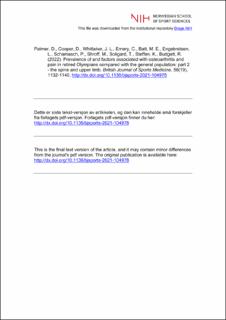| dc.contributor.author | Palmer, Debbie | |
| dc.contributor.author | Cooper, Dale | |
| dc.contributor.author | Whittaker, Jackie L. | |
| dc.contributor.author | Emery, Carolyn | |
| dc.contributor.author | Batt, Mark E | |
| dc.contributor.author | Engebretsen, Lars | |
| dc.contributor.author | Schamasch, Patrick | |
| dc.contributor.author | Shroff, Malav | |
| dc.contributor.author | Soligard, Torbjørn | |
| dc.contributor.author | Steffen, Kathrin | |
| dc.contributor.author | Budgett, Richard | |
| dc.date.accessioned | 2023-01-12T09:54:19Z | |
| dc.date.available | 2023-01-12T09:54:19Z | |
| dc.date.created | 2022-11-01T08:29:05Z | |
| dc.date.issued | 2022 | |
| dc.identifier.citation | British Journal of Sports Medicine. 2022, 56(19), 1132-1140. | en_US |
| dc.identifier.issn | 0306-3674 | |
| dc.identifier.uri | https://hdl.handle.net/11250/3042926 | |
| dc.description | I Brage finner du siste tekst-versjon av artikkelen, og den kan inneholde ubetydelige forskjeller fra forlagets pdf-versjon. Forlagets pdf-versjon finner du på bjsm.bmj.com / In Brage you'll find the final text version of the article, and it may contain insignificant differences from the journal's pdf version. The original publication is available at bjsm.bmj.com | en_US |
| dc.description.abstract | Objectives: (1) To determine the prevalence of spine and upper limb osteoarthritis (OA) and pain in retired Olympians; (2) identify risk factors associated with their occurrence and (3) compare with a sample of the general population. Methods: 3357 retired Olympians (44.7 years) and 1735 general population controls (40.5 years) completed a cross-sectional survey. The survey captured demographics, general health, self-reported physician-diagnosed OA, current joint/region pain and significant injury (lasting ≥1 month). Adjusted ORs (aORs) compared retired Olympians and the general population. Results: Overall, 40% of retired Olympians reported experiencing current joint pain. The prevalence of lumbar spine pain was 19.3% and shoulder pain 7.4%, with lumbar spine and shoulder OA 5.7% and 2.4%, respectively. Injury was associated with increased odds (aOR, 95% CI) of OA and pain at the lumbar spine (OA=5.59, 4.01 to 7.78; pain=4.90, 3.97 to 6.05), cervical spine (OA=17.83, 1.02 to 31.14; pain=9.41, 6.32 to 14.01) and shoulder (OA=4.91, 3.03 to 7.96; pain=6.04, 4.55 to 8.03) in retired Olympians. While the odds of OA did not differ between Olympians and the general population, the odds of lumbar spine pain (1.44, 1.20 to 1.73), the odds of shoulder OA after prior shoulder injury (2.64, 1.01 to 6.90) and the odds of cervical spine OA in female Olympians (2.02, 1.06 to 3.87) were all higher for Olympians compared with controls. Conclusions: One in five retired Olympians reported experiencing current lumbar spine pain. Injury was associated with lumbar spine, cervical spine and shoulder OA and pain for Olympians. Although overall OA odds did not differ, after adjustment for recognised risk factors, Olympians were more likely to have lumbar spine pain and shoulder OA after shoulder injury, than the general population. | en_US |
| dc.language.iso | eng | en_US |
| dc.subject | cervical spine | en_US |
| dc.subject | lumbar spine | en_US |
| dc.subject | osteoarthritis | en_US |
| dc.subject | shoulder | en_US |
| dc.title | Prevalence of and factors associated with osteoarthritis and pain in retired Olympians compared with the general population: part 2 - the spine and upper limb | en_US |
| dc.title.alternative | Prevalence of and factors associated with osteoarthritis and pain in retired Olympians compared with the general population: part 2 - the spine and upper limb | en_US |
| dc.type | Peer reviewed | en_US |
| dc.type | Journal article | en_US |
| dc.description.version | acceptedVersion | en_US |
| dc.source.pagenumber | 1132-1140 | en_US |
| dc.source.volume | 56 | en_US |
| dc.source.journal | British Journal of Sports Medicine | en_US |
| dc.source.issue | 19 | en_US |
| dc.identifier.doi | 10.1136/bjsports-2021-104978 | |
| dc.identifier.cristin | 2067116 | |
| dc.description.localcode | Institutt for idrettsmedisinske fag / Department of Sports Medicine | en_US |
| cristin.ispublished | true | |
| cristin.fulltext | postprint | |
| cristin.qualitycode | 2 | |
